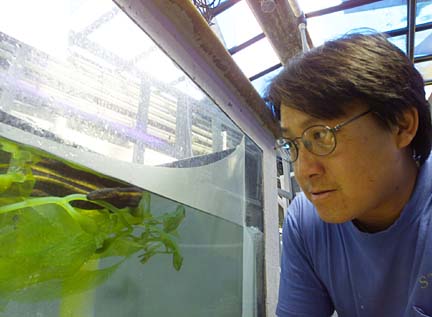


A 2-FOOT yellow-bellied sea snake, rarely seen near shore, "is eating and looks good" after being turned into the Waikiki Aquarium, said Norton Chan, aquarium biologist. Aquarium cares for
2-foot sea snakeBy Helen Altonn
Star-BulletinThree unidentified boys found the snake -- a highly venomous relative of the cobra -- near Swanzy Beach Park.
They put it in a dive bag and turned it in at the Kaaawa Fire Station, which notified the state Agriculture Department's Plant Quarantine Branch.
The snake is being held at the aquarium until officials decide whether it will be displayed or returned to the ocean, said Janelle Saneishi, agriculture spokeswoman.
"We just want to hold it and make sure it's healthy before we decide what to do with it," Chan said.
These snakes live in the open ocean and are not found near islands unless they are injured, sick or blow off course, he said. "For people to find one, normally something happens."
The aquarium's new resident is "a little beat up" but appears to be reviving, he said.
Yellow-bellied sea snakes are black and cream-colored, with a flat paddle-like tail. Though they are a poisonous relative of the cobra, they are not as threatening, Chan said.
When cobras strike they have retractable fangs that pop out when their mouths open up, he noted. The sea snake eats little fish, so it does not have to have fangs popping out, he said. "They're fixed, not retractable. They're pretty small and located below the eyes, halfway through the mouth, not in front of the mouth.
"You can get bit, but the likelihood of getting bit is reduced because the fangs are further back in the mouth."
The snake would have to bite a finger to get a grip on someone because its mouth does not open wide, Chan said.
Last year, he said, there were only eight confirmed sightings of the snake in Hawaii: two on Maui, two on Kauai and four on Oahu.
The Kaaawa find is the first he has heard of this year, Chan said. One of those found before was turned over to the aquarium, but it was injured and did not have full mobility, he said. It was eating and did recover enough that it was put on display, but something was wrong with it and it eventually died, he said.